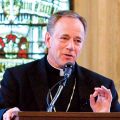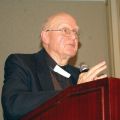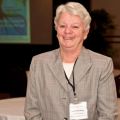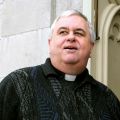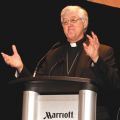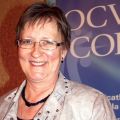Unattached individuals face growing poverty rates, says study
By Deborah Gyapong, Canadian Catholic NewsOTTAWA - Individuals living alone without family ties form a new growing risk-group for poverty, says a new study by Citizens for Public Justice (CPJ) released Oct. 17.
At a news conference, CPJ executive director Joe Gunn blamed the rise of “precarious employment” for the growing risk to unattached working individuals of falling into poverty. Don’t believe the line that simply getting a job will get one out of poverty, he said.
“It has to be a good job,” he said.
“Working-age individuals living on their own are now much more likely to be poor than individuals living in family situations,” says CPJ’s Poverty Trends Scorecard—Canada 2012, released to mark the International Day for the Eradication of Poverty.
The study shows poverty among households with two or more workers accounted for a “shocking” 12 per cent of Canada’s poor. Households with one worker make up 39.1 per cent of Canada’s poor.
“Inadequate income support programs for working-age individuals and families ensure a life of poverty for almost one million Canadians,” the study says.
The study also identifies young adults as “more likely to be poor today than they were three decades ago,” noting fewer young people are working in 2012 than at the peak of the 2008-2009 recession.
Other groups that face higher risk of poverty and the likelihood of long-term poverty are aboriginal peoples, recent immigrants, the disabled and “racialized communities,” the study says.
The study shows the higher poverty levels caused by the recent recession were largely overcome by 2010, though Alberta and British Columbia have not fully recovered.
Not all the news is bad, Gunn pointed out. The study shows that over the past 15 years, Canada has seen a decline in overall poverty rates, “especially among children and seniors.” Gunn said this result shows government support programs can work to reduce poverty.
CPJ reported progress in reducing poverty in Newfoundland and Labrador, Prince Edward Island, Saskatchewan and Quebec.
“Poverty among lone-parent families has fallen as women’s position in the labour market has improved, and their average duration of poverty has decreased,” the study says.
Supports for working age and unattached people have “weakened” since the 1990s, the study says.
“Lack of support is a critical issue with the loss of middle-income jobs in Canada.”
Gunn said the House of Commons has pledged twice to overcome poverty and the House HUMA committee developed a plan that still needs to be implemented. That it has not been shows “a failure of our commitment to show we are here for the common good of all.”
Vancouver program aims to bring Catholics home
By Nathan Rumohr, Canadian Catholic NewsVANCOUVER - The archdiocese of Vancouver is inviting Catholics to come back to their faith this holiday season with a “Catholics Come Home” (CCH) initiative, Archbishop J. Michael Miller announced during his fundraising dinner Oct. 25.
CCH is a multi-faceted campaign that combines media and parish outreach to bring fallen-away Catholics back to the Church. The media component involves commercials produced that will air between Dec. 13 and Jan. 20 on major TV stations in Vancouver. Parishes have been preparing outreach plans to welcome those inspired by the commercials.
“In the archdiocese of Vancouver there may be as many as 250,000 Catholics who need us to reach out and welcome them,” said Miller. “Every one of us has family members, friends or co-workers who once were active Catholics and now are no longer.”
“With the upcoming Catholics Come Home initiative we have a wonderful opportunity to reach out to others and be spiritually renewed in the process,” said Kyle Neilson, director of the office of evangelization for the archdiocese and part of the CCH Vancouver team.
Hundreds of parish representatives gathered at St. Patrick’s, Our Lady of Fatima and St. Matthew’s parishes Sept. 28 to 30 to hear Ryan Hanning, director of parish leadership for the diocese of Phoenix, discuss some of the ideas on how to welcome Catholics back. Hanning’s diocese was the pilot for Catholics Come Home in 2008. The diocese helped produce commercials which later ran in several U.S. dioceses and in other countries.
“When we ran the campaign we didn’t know what to expect and didn’t know who our audience was,” Hanning said.
He shared some of the CCH findings and described the state of Catholicism in Vancouver, saying the west coast city is second only to Berlin as the most secular city in the world.
“Thirty-six per cent of people that live in Vancouver say they are atheist or agnostic,” Hanning reported. “There is a huge mission field here.”
He said there are more than 450,000 registered Catholics in the archdiocese, 17 per cent of the population. Of those, 22.5 per cent attend Mass every week, 12 per cent attend Mass monthly and 42 per cent attend Mass occasionally.
Hanning also talked about the “inactive Catholics” that make up 25 per cent of the Catholic population. He went over some reasons why those Catholics are inactive.
“When we prepared for the campaign we expected the vast majority of those who had left the faith did so because they were angry or mad,” Hanning said. “The opposite was true.”
He said reasons such as the sex-abuse scandal were not actually as statistically high as many had predicted. He said of the 6,000 people who contacted them in the Phoenix diocese, only a few claimed the reason they left the Church was the sex-abuse scandal.
Most people he encountered left for social reasons.
“They live in a society that doesn’t always respect the role of, and the importance of, religion in life.”
Hanning said the challenge for parishes will be to find their own unique way of welcoming returning Catholics.
“I’ve been in parish life and know the challenges,” Hanning said. “I know there is a temptation to respond (to the campaign) with a program; a one size fits all. People don’t want to come back to a program; they want to come back to a person: Christ.”
Fr. Alphonse de Valk feted as a man ahead of his time
By Evan Boudreau, The Catholic RegisterTORONTO - About 300 people from the pro-life community filled a banquet hall at Spirale Restaurant Oct. 18 to honour Fr. Alphonse de Valk, the recently retired editor of Catholic Insight magazine.
“He was ahead of his time with his warning of legalizing abortion,” said Steve Jalsevac, managing director of LifeSiteNews. “In all the years I’ve known Fr. de Valk he’s been faithful, faithful, faithful.”
Jalsevac first got to know de Valk in 1984 when the Basilian priest moved to Toronto from the Prairies, where his pro-life journalism began shortly after penning Morality and Law in Canadian Politics: The Abortion Controversy. Both members of Campaign Life Coalition, which de Valk joined in 1978 while principal of St. Joseph’s College at the University of Edmonton, the two were always able to look past their personal differences in the name of life.
“Both being Dutchmen, actually I’m only half Dutch, we’ve had our differences,” said Jalsevac at The Testimonial Dinner for Fr. Alphonse de Valk, which was sponsored by a number of pro-life organizations. “But I prefer a man who isn’t lukewarm.”
As a post-secondary educator in both Saskatoon and Edmonton during 1970s and early ’80s, de Valk published more than 200 articles addressing abortion issues in papers which circulated on the campus. These writings helped to recruit young pro-life support.
While living in Edmonton de Valk had gathered enough supporters to begin publishing booklets, 12to 24-pages long, focusing on issues facing the pro-life movement. The group produced 36 editions over a 15-year period before de Valk moved eastward and joined Campaign Life Coalition fulltime.
“It was a wonderful thing to find a group of people whom we could associate with and who shared the value of human life, who shared the teachings of the Church,” said de Valk.
He also began writing for The Interim, a Toronto-based pro-life newspaper, that same year and eventually became editor, a position de Valk held from 1987 to 1992.
As a reporter, de Valk made the transition from advocate to activist when, in 1985, he was arrested for chaining himself to the Morgentaler Clinic’s gate. One night in the Don Jail was all de Valk served thanks to the province’s Attorney General withdrawing the charges after hearing a priest was imprisoned.
The arrest didn’t scare off de Valk who continued to be a regular, slightly less radical, picketer outside the clinic every Friday for almost five years — even after the 1989 injunction prohibiting such protests. Over these years he was arrested another eight times and fined $750 or two weeks in jail for trespassing — a fine he hasn’t paid, jail time he has not served.
“Fr. de Valk could always be counted on to state the blunt truth about controversial goings on,” Jalsevic wrote in the evening’s program.
De Valk continued to do just that after leaving The Interim with the launch of Catholic Insight in 1993.
Following a stroke, and his 80th birthday this March, de Valk decided that Catholic Insight’s publisher, the Board of Directors of Life Ethics Information Centre, should seek a new editor.
Although no longer a member of the editorial team, de Valk continues to sit on both the advisory and publishing boards of Catholic Insight.
“God’s grace has allowed us to withstand the sexual revolution,” de Valk said during the dinner’s closing speech.
“Whatever you do, work at it with your whole being. Do it for the Lord rather than for me since you know fully well that you will receive an inheritance from Him as your reward.”
Catholic Charities turns 100
By Evan Boudreau, The Catholic RegisterTORONTO - Catholic Charities of the Archdiocese of Toronto has begun celebrations of its 100th anniversary.
The organization functions as an umbrella charity for Catholic social service agencies in the province of Ontario. In it’s inaugural year the charitable organization funded eight agencies, a number that has since grown to 29 serving about 250,000 people.
“We make a real positive difference in the lives of people,” said Michael Fullan, Catholic Charities’ executive director for the past 19 years. “Often when there isn’t hope we help to re-instill that ... hope.”
These agencies include Providence Healthcare, Covenant House Toronto and Natural Family Planning Association. Among those who benefit from these agencies are impoverished youth, the elderly and those suffering from illness ranging from disabilities to substance abuse issues.
“Those most at risk of falling through the cracks of the service agencies is typically where the Catholic agencies have been responding,” said Fullan. “(They’re) the most vulnerable in society.”
Currently Catholic Charities injects about $8.5 million into the province’s social service network. While most of the money comes from ShareLife, Fullan said a lot of outside funding comes as a result of Catholic Charities’ contributions.
“Our funding is like a catalyst to attracting other funding,” he said. “Governments and other funders recognize the contributions that the Catholic agencies make.”
During his speech at the 33rd Annual Cardinal’s Dinner on Oct. 11, Toronto’s Cardinal Thomas Collins made a point of acknowledging the milestone year for the organization started a century ago by then Archbishop Neil McNeil.
“When it comes to helping others, whether it is those suffering from a natural disaster across the ocean, or those closer to home, faith-based organizations are the first in and last out,” said Collins, adding that centenary celebrations will culminate with a special Mass next September.
Collins praised both the agencies supported by Catholic Charities and parishioners whose donations make the agencies’ work possible.
But Catholic Charities is more than a money allocator.
“Catholic Charities historically had a direct contribution to the development of the present universal health care system in this country,” said Fullan. “That’s something that we should be very proud of.”
That kind of government lobbying continues today, although the area of attention has shifted. Catholic Charities is currently attempting to have the government address child poverty, affordable housing and social service funding.
“We’re trying on the systematic level to make changes that need to happen,” said Fullan. “We’re making some people expendable in our culture and there’s something very wrong with that.”
What the next 100 years will look like for Catholic Charities is unclear to Fullan. What he does know is that demands will change, as always, and Catholic Charities will respond, as always.
D&P’s French youth wing pulls out of fall campaign
By Michael Swan, The Catholic Register(UPDATED 25/10/12)
The French-speaking youth wing of the Canadian Catholic Organization for Development and Peace has withdrawn its support of the organization’s fall education campaign and next spring’s Share Lent drives in protest over a decision to first delay and then change this fall’s education campaign.
Development and Peace’s traditional fall campaign was to have included postcards addressed to Prime Minister Stephen Harper requesting a national consultation on the direction of foreign aid policy. CCCB president Archbishop Richard Smith and CCCB general secretary Msgr. Pat Powers informed Development and Peace’s leaders in September that several bishops were uncomfortable with the directly political tone of the campaign, leading Development and Peace to delay the launch for a month and withdraw the postcards.
“This decision by our leadership undermines the credibility of our movement and renders it impossible to recruit new members or to maintain engagement among our youth groups,” wrote nine francophone youth representatives who met in Montreal just before the fall education campaign launched Oct. 15.
In a “declaration” issued Oct. 16, the representatives claim the way in which the bishops maneuvered Development and Peace into compromising its plans caused them to question the prophetic role of the organization within the Church.
“We have cried and shared our suffering and anger,” they wrote.
The young members said they understood the gravity of withdrawing their support at this time but claimed something had to be done to force reform on the leadership. Instead of participating in the fall campaign the youth wing will launch an internal campaign to return Development and Peace to its democratic roots and original mission.
Attracting new members, especially among youth, is one focus of this fall’s campaign.
“We knew there would be some members who would be very frustrated with this. That’s not a surprise,” said Development and Peace national council president Ronald Breau.
The national council is looking forward to speaking with youth representatives about their concerns, Breau said. Ariane Collin, who represents francophone youth on the national council, will be able to present her concerns at a full national council meeting scheduled for Nov. 30 to Dec. 2. Internal dissension is a normal part of life in Development and Peace, said Breau.
“I don’t think we’re seeing the disintegration of the movement,” he said. Some of the most vocal criticism of CCCB interference in the organization’s affairs has come from Quebec and francophone New Brunswick, but Breau said he doesn’t believe the Catholic movement set up by Canada’s bishops in 1967 is splitting along linguistic lines.
“I don’t see a French-English split. I see that the French members have a real passion, they have a real strong foundation and they really, really believe — and they’re more expressive,” Breau said.
“That’s good for the movement.”
The bishops are not worried about a gulf between English and French opinion on the development agency, said CCCB spokesman Rene Laprise.
"Half of the members of the CCCB standing committee (on Development and Peace) are francophones, as are half the members of the CCODP liaison committee, and our experience with both committees has shown no divisions along linguistic lines," Laprise wrote in an email.
The CCCB has backed the "Do It Justice" fall campaign by announcing the launch and posting a link to the Development and Peace site on it's own web site. A four-page background paper on international development policy got the thumbs up with only minor changes from the CCCB’s committee on Development and Peace and from Development and Peace’s liaison committee for relations with the bishops. The campaign materials also include a video introduction viewable on YouTube. Other campaign materials are available at www.devp.org .
St. Wilfrid’s opens a diverse Year of Faith
By Evan Boudreau, The Catholic RegisterTORONTO - The Year of Faith kicked off Oct. 14 in a multicultural way for one of the most culturally diverse parishes in a city known for its cultural diversity.
At the noon Mass, St. Wilfrid’s Church in northwest Toronto joined other parishes across the archdiocese in kicking off the Year of Faith, but in a way that reflects the face of its parishioners.
“The Year of Faith was inspiration the Church received to reflect on our faith but also on our diversity,” Fr. Massey Lombardi told those gathered.
“There’s about 45 different languages in this parish but I would think if you went to other parishes in the city you would find the same thing.”
To celebrate the cultural melting pot that is his parish and city, Lombardi hung about 40 miniature flags on the walls surrounding the altar. These flags represent the heritage of the parishioners who attend his services weekly. On this Sunday the church, brightened by the colourful attire worn by many, was filled beyond its 1,000-occupancy capacity with parishioners lining the back wall and spilling out into the foyer.
“Those flags are going to stay up all year and we are going to have programs that speak of the diversity,” said Lombardi. “This parish here is very diverse and we want to celebrate that. It’s really trying to build an understanding of cultures and respect.”
Fol lowing communion Lombardi invited parishioners to offer a sign of peace and recite the Our Father in their native language. After the service parishioners headed to the parish hall to sample lunch dishes as diverse as the cultural attire they donned, sharing their diversity as one community.
“It’s both a joining together and sharing food and there is nothing like joining together to share food,” said Lombardi.
Lombardi said plans are in the works to expand this all-encompasing atmosphere outside of the church’s walls.
On Oct. 21 the parish will dedicate a statue to St. Padre Pio.
“This is really a segue into all the other things we can do in terms of our liturgy, in terms of our practice, our programs, but also in terms of our outreach to the poor, sick and the marginalized in our community,” said Lombardi. “Faith is not faith in the vacuum, it’s promoted, it’s increased, it’s deepened through cultures.”
Real love, support key to battling abuse
By Michael Swan, The Catholic RegisterTORONTO - For most of her career as a leading pediatrician and professor of medicine, Sr. Nuala Kenny diagnosed cancers, complex infections and syndromes in some of the smallest, frailest and most precious bodies among us.
At 70, having survived her own cancer, Kenny has turned her diagnostic eye on the body of Christ itself.
In Healing the Church: Diagnosing and Treating The Clergy Sexual Abuse Crisis, Kenny examines the history, cause and symptoms of the greatest crisis the Church has faced in its modern history — sexual abuse of children and youth by priests, and bishops who protected and reassigned offending priests.
She doesn’t come at the subject out of nowhere. Kenny was there at ground zero, when the first major sex abuse scandal in North America broke in Newfoundland. She served on then-St. John’s Archbishop Alphonsus Penny’s unprecedented commission of enquiry when the Mount Cashel scandal was followed by Fr. James Hickey’s 1988 arrest on 32 counts of sexual misconduct.
From the 1990 Newfoundland report, Kenny went on to contribute to the Canadian Conference of Catholic Bishops’ guide to sexual abuse policies called From Pain to Hope. She has been consulted by individual bishops and bishops’ conferences ever since. In February this year she spoke at the Vatican-sponsored symposium
“Towards Healing and Renewal” in Rome.
If people think tighter screening of seminary candidates or stricter enforcement of canon law will somehow solve the problem, then they don’t understand, Kenny told The Catholic Register.
“Somehow or other, the response of our leaders in the Church still sits with a diagnosis of this is the sins of individual men — either individual perpetrators or individual mismanagers — and therefore the treatment has to do with protocols, policies, screening and education,” she said.
“This is not the right diagnosis. I’m a doctor who knows about right diagnosis. The way we responded here — secrecy, denial, minimization of harm, protection of image, protection of offender, avoidance of scandal — we responded that way because that’s who we are. We are not a people of justice and compassion. We are not a people open to the truth of what happens when the vulnerable are hurt.”
Kenny admits to passion and righteous indignation, but not anger.
“I live in hope, right?”
Like others before her, Kenny finds the root of the problem in clericalism, that false sense of greater honour bestowed on the ordained.
But she doesn’t blame priests and bishops any more than she blames lay people who insist on putting their priests on pedestals.
“It’s a kind of superficial deference, a superficial bowing to power and authority that is not based on any real, loving kind of relationship,” she said. “We have lay people who have not been helpful.”
The cure will be long and difficult, but it will start with replacing artificial and superficial relationships with real love and support, she said.
“I want us to find a new way to be of support to one another, priests and people.”
The book itself aims to be part of that culture change, Kenny said. The 127-page softcover book is the size of a school workbook. Each chapter ends with Scripture passages, questions and reflections intended to spark conversation. It’s a book meant to be read and talked about by priests and parishioners together.
“We have a Church that doesn’t have a tradition of talking together about things,” she said. “The key in all abuse is to allow people to speak of it. If you can’t name it then you can’t identify what must be healed. There’s nowhere to go unless you name it first.”
Healing the Church: Diagnosing and Treating The Clergy Sexual Abuse Crisis is available from Novalis for $24.95.
Serra Canada supporting vocations for 60 years
By Ruane Remy, The Catholic RegisterTORONTO - Serra Canada is celebrating 60 years of encouraging and supporting those who are contemplating religious life.
“We need priests particularly to keep our Church alive,” said Anne MacCarthy, current president of the Serra Club of Toronto Downtown. “We just know that there’s a strong need for vocations to the priesthood and religious life in the Catholic Church, so we think we have a stake in it.”
The Toronto club is part of Serra Club International, a non-profit organization of lay Catholics devoted to praying and fostering vocations to the priesthood and other consecrated religious vocations.
MacCarthy and her husband Dane have been part of Serra since 2003. One morning, a neighbour walked her home from church, she recalls, and asked her to join Serra.
“I hauled my husband behind me,” she jokes, and nine years later, even their son has joined the club.
“The harvest is plentiful, the labourers are few, and so we want to encourage as many priests and potential sisters to come forward,” Dane, treasurer and past president of Serra Club of Toronto Downtown, said on the importance of lay people in another’s vocation. “Being a priest or a sister is not an easy task, so we’re trying to affirm those who have chosen that path as well. We offer our support to them and we pray for them on a regular basis.”
The MacCarthys enjoy the countless speakers the club invites to its bi-monthly meetings. And at the Serra Fall Conference in late September, celebrating the 60th anniversary of Serra in Canada, Anne presented an award to the longest-serving Serran in the world, Vincent DeMarco, who joined the local branch shortly after it was founded.
The Serra Club began in Seattle in 1935. The club was named after Spanish Franciscan Blessed Junipero Serra who founded missions in Mexico and the United States. In 1952, the Toronto Downtown club was the first to open outside of the United States.
There are currently three clubs in Toronto, 15 in Canada and 1,109 in 46 countries across the globe.
Serra Club provides “an opportunity to hear speakers help us with our faith and with matters of day-to-day concern for Catholics,” said Celeste Iacobelli, a past president of the Toronto Central Serra Club and a current board member of the Serra Canada Foundation.
Joining Serra “gave me an opportunity to meet with other like-minded Catholics interested in promoting vocations to the priesthood, interested in supporting our Catholic principles,” he said.
Iacobelli and the MacCarthys agree that one of the most memorable Serran events is the Ordinandi dinner, where seminarians soon to be ordained tell their vocation story.
“It’s the largest gathering of Catholics in the archdiocese of Toronto,” said Iacobelli.
He finds it “particularly satisfying” when students from schools across the archdiocese are invited to the dinner.
Some students attend a dialogue session with the ordinandi.
“It gives them a wonderful perspective on what it means to be an ordained priest, what went through the process of discernment, how the young men struggled with their decisions in some cases, how they left other careers behind.”
CCCB to outsource publishing division
By Deborah Gyapong, Canadian Catholic NewsOTTAWA - The Canadian Conference of Catholic Bishops (CCCB) will outsource its in-house publishing division and cut the position of senior advisor on social justice.
“No area of the conference is not affected by the effort to cut down expenses and maximize productivity,” said CCCB General Secretary Msgr. Patrick Powers. “We have had to rethink the way we do things, to do more and to cost less.
“For many y e a r s the bishops have been grappling with finances,” he said. “The dioceses cannot afford to pay the amount of money required to keep the conference running.”
The per capita rate charged each diocese based on Census data of baptized Catholics has remained unchanged this year, but some poorer dioceses are having trouble meeting their assessment, he said.
Powers said he has met with CCCB employees to explain the fact the conference does not have unrestricted funds and must rein in spending “or the bank will close our doors.”
“It’s always so difficult to see people lose their jobs,” he said. “The bishops don’t take that lightly.”
Details of the outsourcing will be revealed later next month after the arrangements are finalized, he said, noting eight to 10 jobs could be affected.
The bishops have been studying the issue of CCCB Publications for 15 years, Powers said. The key, however, was finding a reputable North American company with a reputation for treating its employees well, he said.
“It is a communications firm we have dealt with in the past,” he said.
The position occupied by Francois Poitras, the senior advisor for social justice, has also been eliminated, said Powers. Among his duties, Poitras occupied the position of secretary to the Justice and Peace Commission.
Powers said many aspects of the CCCB secretariat’s operation have needed updating, especially its technological infrastructure.
Dignity of the human key in all health decisions
By Michael Swan, The Catholic RegisterTORONTO - What makes a hospital, nursing home or hospice Catholic isn’t the cross in the lobby. It is the decisions made in each and every examination room, operating theatre, boardroom and clinic.
More than 100 Catholic health care institutions in Canada have just received a new guide to help them make those decisions. The third edition of the Catholic Health Alliance of Canada’s Health Ethics Guide has been almost five years in the making and thoroughly updates the 2000 edition.
The Canadian book is fundamentally different from the Ethical and Religious Directives manual produced by the United States Conference of Catholic Bishops, said contributing editor Sr. Nuala Kenny. Rather than a legalistic code of forbidden acts gleaned from Catholic moral theology, the new Health Ethics Guide begins with goals and ideals shared by doctors, nurses, administrators in all Catholic institutions, she said.
“The fact of the matter is that the most important thing for those who are in Catholic health care is their self-identification that health care is not simply a business or a service like any other,” said Kenny. “It is the continuation of the healing and reconciling mission of Jesus Christ. This is a recommitment to that notion.”
The recommitment starts with Scripture. The Health Ethics Guide begins with the parable of the Good Samaritan.
“The Good Samaritan has every element of contemporary health care,” said Kenny. “It has the questions about who is your neighbour? Where are the needs? Today, what are the unmet needs?”
The best part of the Canadian guide is that it isn’t produced by outsiders and then imposed on Catholic health institutions, said Kenny, a retired pediatrician, professor of medicine and professor of medical ethics.
“This is produced by people who are in the trenches,” she said.
The central idea that drives the Health Ethics Guide is the inherent dignity of every human being, said Bishop Noel Simard of Valleyfield, Que. Simard is a former professor of moral theology who served as part of the writing team on the guide.
“It is not because you have the capacity to make decisions that you have dignity,” Simard told a Catholic Health Association of Ontario convention where the new Health Ethics Guide was launched Oct. 11 in Toronto. “It is because you are human.”
If the dignity of the human is central to every decision in health care, then certain conclusions are unavoidable, he said.
“Because we are Catholic and we try to follow the Gospel, we have a duty of special care to the poor, the weak and the vulnerable,” he said.
“We need to look at the common good.”
There’s no big news regarding settled issues from abortion to assisted suicide, said Kenny.
“If you compare this to the previous version, there’s nothing new and groundbreaking in the sense of a new teaching,” she said.
But the guide does offer concrete help to institutions looking to foster a Catholic identity in a situation where not everyone working for the hospital is Catholic and not everyone served by the hospital is Catholic.
The guide bears the Nihil Obstat of the permanent council of the Canadian Conference of Catholic Bishops. It is published by the Catholic Health Alliance of Canada, distributed by Novalis. The 162-page softcover book sells for $20.
PQ’s ‘medical aid in dying’ sugarcoats euthanasia, foes say
By Deborah Gyapong, Canadian Catholic NewsOTTAWA - Anti-euthanasia groups are pushing back against Parti Quebecois plans to bring in euthanasia under the euphemistic guise of “medical aid in dying.”
Quebec grassroots group Living with Dignity director Linda Couture said the PQ is masking its euthanasia plans behind the words medical aid in dying without defining them, she said. “Does it mean (lethally) injecting people or not?”
Couture expressed alarm at how fast the government is moving, noting the new government hopes to have a bill passed by June next year.
In early October, radio station CJAD reported Parti Quebecois junior social services minister Veronique Hivon hoped to introduce legislation soon to help people who face unbearable end-of-life suffering. Though euthanasia and assisted suicide are both illegal in Canada’s Criminal Code, and under federal jurisdiction, Hivon said health is a provincial matter. The province could also direct Crown prosecutors not to prosecute cases that fall under the guidelines for medical aid in dying, she said.
Couture said using health care and directing prosecutors in this manner is bringing in “euthanasia through the back door” while hiding behind a vague, nice-sounding phrase.
The province’s plans to move in this direction stem from recommendations of an all-party Dying with Dignity committee that held hearings across Quebec and released a report last March, Couture said. Though 60 per cent of the presenters to this committee opposed euthanasia and assisted suicide, the committee’s report recommended “medical assistance in dying” for those suffering and close to death. It ignored grassroots rejection of euthanasia and assisted suicide, Couture said.
“Everybody’s in favour of palliative care. Let’s work on what unites us not what divides us.”
Couture dared the small group of physicians who are pushing for euthanasia to put their faces on a public poster the way members of a new anti-euthanasia physicians’ organization has. The Physicians’ Alliance for Total Refusal of Euthanasia is led by the renowned Dr. Balfour Mount, considered the father of palliative care in Canada. His organization boasts 24 prominent physicians who have allowed their pictures to be published.
“We are physicians who see any law allowing doctors to intentionally end the life of their patients as contrary to the goals of medicine and the good of our patients, especially the most vulnerable and those who cannot speak for themselves,” says the group’s web site. “We intend to make known to the public the grave dangers inherent in such a law.”
At its web site, the group has a declaration and petition for both doctors and concerned citizens to circulate and send to their provincial representatives.
“To provoke death voluntarily, by lethal injection or any other method, cannot be considered under any circumstance as ‘medical care’ and is contrary to medical ethics,” the declaration reads. “It is never necessary to kill a patient in order to end his or her suffering.”
Euthanas ia Prevention Coalition director Alex Schadenberg said Quebec’s sleight of hand could bring in Belgium-style euthanasia and its lack of safeguards. A study published in the Canadian Medical Association Journal found that one-third of euthanasia deaths in Belgium were done without explicit request or consent. If medical aid in dying means doctor’s giving patients lethal injections, that is euthanasia, he said. Doctors writing prescriptions for patients knowing they will use the drugs to kill themselves is doctor-assisted suicide.
The Catholic Organization for Life and Family (COLF) said Hivon’s plans to introduce a bill are not a surprise because it was part of the Parti Quebecois’ platform. But she questioned whether the government listened to palliative care experts or the democratic results of the Dying with Dignity consultations.
“Medicine, today, can control almost any pain,” said COLF director Michele Boulva. “And, in extreme cases, palliative sedation can be used to relieve patients.”
The pro-euthanasia lobby has been trying to show Belgium-style euthanasia is working well, she said, but a group of Belgian professionals said in a manifesto signed last June that the slippery slope they had warned of 10 years ago when Belgium decriminalized euthanasia had become a reality.
“We are now very worried by suggestions that minors and mentally ill people could also be euthanized,” the manifesto says. “As we expected, once the prohibition has been lifted, we are rapidly moving towards the banalisation of euthanasia.”
“Can you even imagine teaching future doctors how to kill?” Boulva asked.
“COLF encourages Quebec Catholics and all people who have any respect for the inalienable dignity and worth of all human beings to contact their elected members of the Assemblée nationale, asking them with insistence to oppose any attempt to legalize euthanasia. This lethal practice must not enter our hospitals.”


